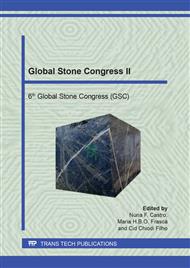[1]
R. Martins, L. Lopes, F. Bilou, (2015) – As Pedreiras de Mármore ao Longo dos Tempos; Callípole, Revista de Cultura nº 22; Câmara Municipal de Vila Viçosa; p.83 – 100.
Google Scholar
[2]
L. M. Brito da Luz, (2005). Análise Crítica ao Modelo de Desenvolvimento do Sector das Pedras Naturais: o Caso dos Mármores no Triângulo Estremoz – Borba – Vila Viçosa, 1980 – 2003; Mestrado em Economia e Estudos Europeus; Universidade Técnica de Lisboa, Instituto Superior de Economia e Gestão; p.230.
DOI: 10.30553/sociologiaonline.2020.22.6
Google Scholar
[3]
L. Lopes, & R. Martins, (2014). Global Heritage Stone: Estremoz Marbles, Portugal. From: Pereira, D., Marker, B. R., Kramar, S., Cooper, B. J. & Schouenborg, B. E. (eds) Global Heritage Stone: Towards International Recognition of Building and Ornamental Stones. Geological Society, London, Special Publications, 407, http://dx.doi.org/10.1144/SP407.10.
DOI: 10.1144/sp407.10
Google Scholar
[4]
L. Lopes, & R. Martins, (2015). Vila Viçosa: Património Geológico, Potencial Científico e Geoturismo. Callipole – Revista de Cultura n.º 22; Câmara Municipal de Vila Viçosa; p.101 – 119.
Google Scholar
[5]
R. Martins, C. Varela, L. Lopes, C. Valério, M. Valério, (2012). Afinal o Navegador Cabrilho Também Partiu de Vila Viçosa! Callípole, Revista de Cultura nº 20; Câmara Municipal de Vila Viçosa; p.353 – 366.
Google Scholar
[6]
R. Martins, L. Lopes, L. Brito da Luz, D. Germano, N. Melo, (2016). Museu do Mármore – O Futuro, Presente! Callípole, Revista de Cultura nº 23; Câmara Municipal de Vila Viçosa; p.227 – 256.
Google Scholar
[7]
A. Moura, (coord.); C. Carvalho, I. Almeida, J. Saúde, J. Ramos, J. Augusto, (2007). Mármores e calcários ornamentais de Portugal, 383 pp.
Google Scholar
[8]
G. Oliveira, (2008). Recuperação ecológica de pedreiras – um caso de estudo na Serra da Arrábida, http://naturlink.pt/article.aspx?menuid=16&cid=92987&bl=1, consulted on April 20, (2019).
Google Scholar
[9]
WBCSD (2011). Guidelines on quarry rehabilitation. Cement Sustainability Initiative (CSI). WBCSD, Conches-Geneva, Switzerland, 32 pp, http://wbcsdcement.org/pdf/CSI%20Guidelines%20on%20Quarry%20Rehabilitation%20(English)_Dec%202011.pdf, consulted on April 20, (2019).
Google Scholar
[10]
G. Lucas, P. Michell, & N. Williams, (2011). It's Official: Quarrying Adds to Biodiversity. Agg-Net.com, pp.25-29.
Google Scholar
[11]
D. L. C. Germano, (2013). Análise da evolução da recuperação ecológica em pedreiras de mármore inativas no anticlinal de Estremoz: avifauna, flora e vegetação. Tese de Mestrado em Qualidade e Gestão do Ambiente. Universidade de Évora, Évora. 169 pp.
DOI: 10.32932/rpia.2022.03.074
Google Scholar
[12]
Equipa Atlas (2008). Atlas das Aves Nidificantes em Portugal (1999 – 2005). Insituto da Conservação da Natureza (ICN), Sociedade Portuguesa para o Estudo das Aves (SPEA), Parque Natural da Madeira e Secretaria Regional do Ambiente e do mar. Assírio & Alvim, Lisboa. 590 pp.
DOI: 10.11606/d.91.2004.tde-20062005-163545
Google Scholar
[13]
M. Cabral, (coord.); J. Almeida, P. Almeida, T. Delinger, N. Ferrand de Almeida, M. Oliveira, J. Palmeirim, A. Queiroz, L. Rogado, & M. Santos-Reis, (eds) (2005). Livro vermelho dos vertebrados de Portugal. Instituto da Conservação da Natureza (ICN), Lisboa. 660 pp.
Google Scholar
[14]
C. Godinho, J. E. Rabaça, & P. Segurado, (2010). Breeding bird assemblages in riparian galleries of the Guadiana River basin: the effect of spatial structure and habitat variables. Ecological Research, 25 (2): 283-294.
DOI: 10.1007/s11284-009-0655-9
Google Scholar


